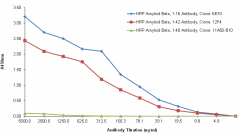- Regulatory Status
- RUO
- Other Names
- AAA, ABETA, ABPP, AD1, APPI, CTFgamma, CVAP, PN-II, PN2, Amyloid beta A4 protein, preA4, protease nexin-II, peptidase nexin-II, alzheimer disease amyloid protein, cerebral vascular amyloid peptide, APP, Amyloid Precursor Protein
- Ave. Rating
- Submit a Review
- Product Citations
- 2 publications

| Cat # | Size | Price | Quantity Check Availability | Save | ||
|---|---|---|---|---|---|---|
| 932501 | 500 µg | $223 | ||||
| 932502 | 1 mg | $440 | ||||
Amyloid Beta (Aβ) peptides are derived from amyloid precursor proteins (APP) through sequential proteolytic cleavage of APP by β-secretases and γ-secretases generating diverse Aβ species. Aβ can aggregate to form soluble oligomeric species and insoluble fibrillar or amorphous assemblies. Some forms of the aggregated peptides are toxic to neurons. Alzheimer's disease is characterized by the accumulation of aggregated Aβ peptides in senile plaques and vascular deposits.
Product DetailsProduct Details
- Verified Reactivity
- Human
- Source
- Chemically Synthesized
- Molecular Mass
- 4514.1
- Purity
- ≥95%, % Peak Area by HPLC
- Formulation
- Lyophilized white powder
- Storage & Handling
-
Peptide is shipped at ambient temperature. Upon receipt, store lyophilized powder at ≤ -20°C. Reconstituted peptide should be aliquoted and stored at ≤ -20°C. Do not freeze/thaw.
Peptide Reconstitution: It is recommended to use 1% NH4OH as the solvent followed by immediate dilution in buffer (i.e. PBS). Add 1% NH4OH directly to the lyophilized powder (add 35-40 µL to 0.5 mg or 70-80 µL to 1.0 mg), then immediately dilute the solution in your buffer to a concentration of 1.0 mg/mL or less. The peptide cannot be stored in 1% NH4OH long-term. - Application
-
Direct ELISA Assay
- Recommended Usage
-
Validated in Direct ELISA as coating peptide.
The peptide may also be useful in additional applications such as Western Blot and Immunoprecipitation. Optimal conditions to be determined by end user.
- Application Notes
-
Direct ELISA: Peptide Coat Concentration 0.2 µg/mL
- Product Citations
-
Antigen Details
- Structure
- Aβ denotes peptides of 36-43 amino acids generated from cleavage of APP by secretases. Aβ has an apparent molecular mass of about 4 kD.
- Distribution
-
Tissue sources: Primarily nervous system, but also adipose tissue, intestine, muscle.
Distribution: Cytosol, endosomes, nucleus, plasma membrane, extracellular, and golgi apparatus. - Function
- The normal function of Aβ is not well understood. Several potential physiological roles have been proposed, including: activation of kinase enzymes; protection against oxidative stress; regulation of cholesterol transport; transcription factor, and as an anti-microbial agent.
- Biology Area
- Cell Biology, Neurodegeneration, Neuroscience, Protein Misfolding and Aggregation
- Molecular Family
- APP/β-Amyloid
- Antigen References
-
- Kumar A, et al. 2015. Pharmacol. Rep. 67(2):195.
- Sadigh-Eteghad S, et al. 2015. Med. Princ. Pract. 24(1):1
- Hampel H, et al. 2015. Expert Rev. Neurother. 15(1):83.
- Puig KL, et al. 2012. Exp. Gerontol. 48(7): 608.
- Selkoe DJ, et al. 2016. EMBO Mol. Med. 8(6):595.
- Walsh DM, et al. 2007. J. Neurochem. 101(5):1172.
- Gene ID
- 351 View all products for this Gene ID
- UniProt
- View information about beta-Amyloid 1-42 on UniProt.org

 Login/Register
Login/Register 





















Follow Us